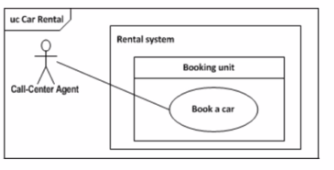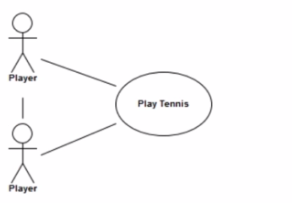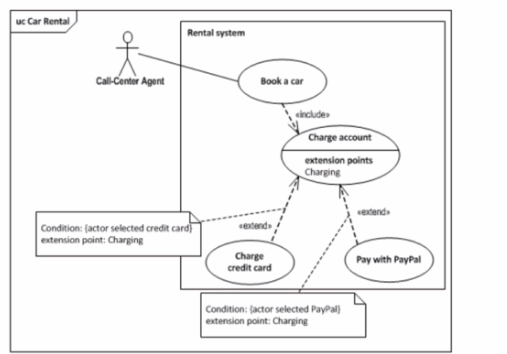Master OMG-OCUP2-FOUND100 Exam with Reliable Practice Questions
Choose the correct answer:
Consider the following diagram:

Who is the owner of the Use Case "Book a car"?
Correct : C
In the context of UML Use Case diagrams, the 'owner' of a use case is the system or unit that provides the services of the use case. The use case 'Book a car' is contained within the 'Rental system' boundary, which is represented as a rectangle in the diagram. This indicates that 'Book a car' is a function or service provided by the 'Rental system.'
The 'Call-Center Agent' is an actor that interacts with the use case, but it does not own it. The 'Car Rental' seems to be a higher-level packaging element (like a system name), but it is not the immediate container of the use case. The 'Booking unit' is a part of the 'Rental system' that is specifically responsible for the 'Book a car' functionality, but in terms of UML semantics, the use case is owned by the system that contains it, which in this case is the 'Rental system.'
Therefore, the correct answer is:
C . Rental system
Start a Discussions
Choose the correct answer:
Which diagram contains only valid relationships?
A)

B)

C)

D)

Correct : A
In UML Use Case diagrams, there are specific relationships that are valid between actors and use cases, as well as between the use cases themselves:
Associations between actors and use cases indicate that an actor participates in the use case. It is depicted as a solid line.
Includes are dependencies that specify that one use case (the base) includes the behavior of another use case (the included). It is depicted with a dashed arrow with the stereotype include.
Extends are dependencies where one use case (the extension) conditionally adds to the behavior of another use case (the base). It is depicted with a dashed arrow with the stereotype extend.
Let's analyze the provided options:
A) This diagram shows simple associations between actors and use cases, which is a valid relationship in UML use case diagrams.
B) This diagram attempts to use include relationships directly between actors and use cases, which is not correct. The include relationship is used between use cases, not between an actor and a use case.
C) This diagram shows a solid line arrow from one use case to another, which is not a recognized relationship in UML use case diagrams.
D) This diagram attempts to use extend relationships directly between actors and use cases, which is not correct. The extend relationship is used between use cases, not between an actor and a use case.
Therefore, the only diagram that contains only valid relationships according to UML standards is Option A.
Start a Discussions
Choose the correct answer:
Exactly two Player Instances are involved in the "Play Tennis" Use Case.
Which diagram depicts this scenario correctly?
A)

B)

C)


Correct : C
In UML use case diagrams, when specifying the number of actors involved in a use case, a multiplicity marker can be used. The multiplicity marker is a number placed near the actor symbol that denotes how many instances of the actor are involved in the use case.
Option C correctly uses a multiplicity marker of '2' next to the actor 'Player', which indicates that exactly two instances of 'Player' are involved in the 'Play Tennis' use case.
Here is a brief explanation of why the other options are incorrect:
A) Option A shows two separate 'Player' actors involved in 'Play Tennis' without a multiplicity marker, implying possibly different kinds of players, but does not specify that exactly two instances are required. B) Option B shows two 'Player' actors involved in 'Play Tennis' without a multiplicity marker, also not specifying the exact number of instances required. D) Option D uses a multiplicity marker, but it is incorrectly placed near the 'Play Tennis' use case instead of the 'Player' actor, which does not follow UML notation for indicating actor multiplicity.
Therefore, the correct answer is:
C . Option C
Start a Discussions
Choose the correct answer:
In the model shown below, what is gained by using the Extend relationship?

Correct : C
In UML, the extend relationship indicates that the behavior defined in the extending use case (the extension) can be inserted into the behavior defined in the extended use case (the base). The extension occurs only under certain conditions, which are specified by the extension points. This relationship allows for the addition of optional behavior to a use case, which can be activated under certain conditions.
The diagram provided shows an extension relationship where 'Charge credit card' and 'Pay with PayPal' are extending 'Charge account' use case at the 'Charging' extension point.
The key benefit of using the extend relationship in this context is that it allows for the flexible addition of new behaviors (like new payment methods) without modifying the main use cases. It helps in evolving the system by adding optional behaviors that only occur under certain conditions, which is mentioned as an option:
C . This Use Case model could be updated with further payment methods without changing the main Use Cases 'Book a car' and 'Charge account'.
This means that new payment methods could be incorporated as additional extending use cases in the future, just like 'Charge credit card' and 'Pay with PayPal'.
The other options do not correctly describe the use of the extend relationship: A) extend relationships do not replace the need for behavior descriptions such as activities. B) It's not about functional decomposition; it's about adding optional or conditional behavior. D) extend is not a taxonomic relationship and does not extract general descriptions into a super Use Case; rather, it adds behavior under certain conditions.
Therefore, the correct answer is:
C . This Use Case model could be updated with further payment methods without changing the main Use Cases 'Book a car' and 'Charge account'.
Start a Discussions
Choose the correct answer:
How many valid Action notations are shown below?

Correct : D
UML 2 Foundation concepts for activity diagrams, there are three valid action notations shown. Here's a breakdown of the elements and why answer D is the most accurate:
The diagram displays an activity diagram with a main flow and a fork followed by a join.
Main Flow:This starts with an action labeled 'Fill Order'.
Fork:The path splits into two branches after 'Fill Order'.
Branch 1:This branch leads to an action labeled 'Print Paycheck'.
Branch 2:This branch leads to an action labeled 'Send Invoice'.
Join:The two branches converge into a join element.
Following the Join:An action labeled 'End' is present after the join.
Explanation for Valid Actions:
Fill Order:This clearly represents an action within the activity diagram.
Print Paycheck:This is another valid action on a separate branch.
Send Invoice:Similarly, this is an action on the other branch.
Explanation for Why Other Options are Incorrect:
A . 0:There are clearly multiple actions depicted in the diagram.
B . 1:There are more than one valid action shown.
C . 2:While there are actions before the fork, there's also a valid action ('End') after the join.
E . 4:Counting the join element as an action results in an overcount. Joins represent control flow elements to synchronize multiple paths, not actions themselves.
Reference
Start a Discussions